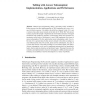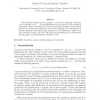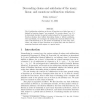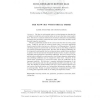CORR
2010
Springer
14 years 5 months ago
2010
Springer
In a previous work we introduced slice graphs as a way to specify both infinite languages of directed acyclic graphs (DAGs) and infinite languages of partial orders. Therein we fo...
SEMWEB
2010
Springer
14 years 6 months ago
2010
Springer
We present a scalable, SPARQL-based computational pipeline for testing the lattice-theoretic properties of partial orders represented as RDF triples. The use case for this work is ...
JELIA
2010
Springer
14 years 6 months ago
2010
Springer
Tabled Logic Programming (TLP) is becoming widely available in Prolog systems, but most implementations of TLP implement only answer variance in which an answer A is added to the t...
DAM
1999
14 years 7 months ago
1999
The achromatic number (G) of a graph G = (V, E) is the maximum k such that V has a partition V1, V2, . . . , Vk into independent sets, the union of no pair of which is independent...
JCT
2000
14 years 8 months ago
2000
A partial order on Z obtained by taking the transitive closure of a random relation {i < j and there is an edge ij} is studied. Randomness stems from postulating that an edge ij...
JSYML
2007
14 years 8 months ago
2007
We investigate the complexity of various combinatorial theorems about linear and partial orders, from the points of view of computability theory and reverse mathematics. We focus ...
SCL
2008
14 years 8 months ago
2008
In this work, the problem of estimating the state in systems with continuous and discrete variables is considered. A cascade state estimator on a partial order is constructed and ...
ORDER
2006
14 years 8 months ago
2006
The C-subfunction relations on the set of functions on a finite base set A defined by function classes C are examined. For certain clones C on A, it is determined whether the part...
MOR
2008
14 years 8 months ago
2008
The flow set with partial order is a mixed-integer set described by a budget on total flow and a partial order on the arcs that may carry positive flow. This set is a common substr...
JCO
2008
14 years 8 months ago
2008
The problem of partitioning a partially ordered set into a minimum number of chains is a well-known problem. In this paper we study a generalization of this problem, where we not ...




